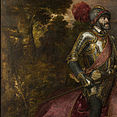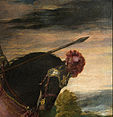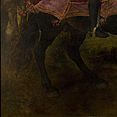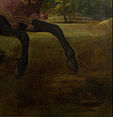
File:Carlos V en Mühlberg, by Titian, from Prado in Google Earth.jpg

| |
This is a file from the Wikimedia Commons. Information from its description page there is shown below.
Commons is a freely licensed media file repository. You can help. |
 |
A higher resolution version of this image is available as a set of tiles. Click on the grid below to access these.
|
| |
|
 |
 |
 |
 |

Summary
|
Warning |
Some browsers may have trouble displaying this image at full resolution: This image has a large number of pixels and may either not load properly or cause your browser to freeze. | Interactive large-image-viewer ( non-Flash) |
|---|
| Artist |
|
|||||||||||||||||||||||
| Title | Italian: Ritratto di Carlo V a cavallo Equestrian Portrait of Charles V |
|||||||||||||||||||||||
| Date | 1548 | |||||||||||||||||||||||
| Medium | oil on canvas | |||||||||||||||||||||||
| Dimensions | 332 × 279 cm (130.7 × 109.8 in) | |||||||||||||||||||||||
| Current location |
|
|||||||||||||||||||||||
| Planta Primera Sala 11 | ||||||||||||||||||||||||
| Notes |
Deutsch: Dieses Porträt von Kaiser Karl V. (1500-1558) zu Pferde entstand im Gedenken an den Sieg der kaiserlichen Truppen über die Protestanten bei Mühlberg. Die scheinbare Schlichtheit der Komposition birgt eine vielschichtige Symbolik, die Karl V. in seiner Eigenschaft als christlicher Ritter und Erbe der römischen Kaisertradition zeigt. Ein Beispiel hierfür ist die Lanze, die der Kaiser in seiner rechten Hand hält und die nicht nur ein Machtsymbol der Cäsaren war, sondern auch auf die Waffe des Heiligen Georg und die Lanze des Longinus während der Passion Christi anspielt (Longinus war ein römischer Soldat, der seine Lanze in den Leib Christi stieß und später zum Christentum übertrat.).
Als formale Vorläufer der Komposition werden die Darstellungen der Reiterstatue von Kaiser Mark Aurel (121-180) in verschiedenen Stichen Albrecht Dürers, wie „Ritter, Tod und Teufel“, sowie Werke von Hans Burgkmair genannt. Die kaiserliche Rüstung ist Teil der Waffensammlung des Madrider Königspalastes. Das Werk wurde für Maria von Ungarn geschaffen und geriet zum dynastischen Innbild schlechthin des österreichischen Königshauses. Im Jahr 1827 wurde es in die Sammlung des Prado-Museums aufgenommen. |
|||||||||||||||||||||||
| References | Referenznummer P00410 | |||||||||||||||||||||||
| Source/Photographer | The Prado in Google Earth: Home - 7 th level of zoom, JPEG compression quality: Photoshop 10. | |||||||||||||||||||||||
Licensing
The official position taken by the Wikimedia Foundation is that "faithful reproductions of two-dimensional public domain works of art are public domain, and that claims to the contrary represent an assault on the very concept of a public domain". For details, see Commons:When to use the PD-Art tag. |
|||||
File usage
Metadata
| Width | 29,495 px |
|---|---|
| Height | 34,997 px |
| Bits per component |
|
| Compression scheme | Deflate (PKZIP) |
| Pixel composition | RGB |
| Orientation | Normal |
| Number of components | 3 |
| Horizontal resolution | 72 dpi |
| Vertical resolution | 72 dpi |
| Data arrangement | chunky format |
| Software used | Adobe Photoshop CS5.1 Windows |
| File change date and time | 23:04, 9 November 2012 |
| Colour space | Uncalibrated |
| Date and time of digitizing | 22:20, 8 November 2012 |
| Date metadata was last modified | 15:04, 9 November 2012 |
| Unique ID of original document | xmp.did:29554ED6032BE21193CDD2DE43361F08 |
Want to know more?
Wikipedia for Schools is one of SOS Children's many educational projects. SOS Children believes education is an important part of a child's life. That's why we ensure they receive nursery care as well as high-quality primary and secondary education. When they leave school, we support the children in our care as they progress to vocational training or higher education. Have you heard about child sponsorship? Visit our web site to find out.



